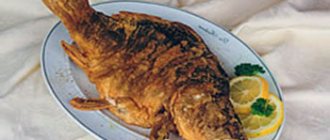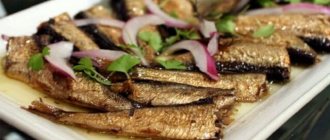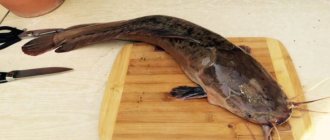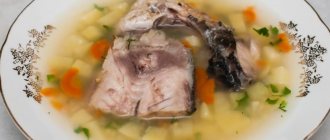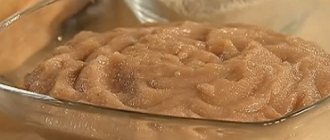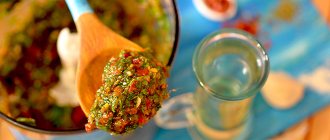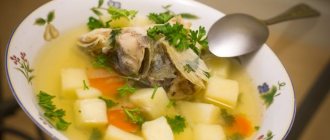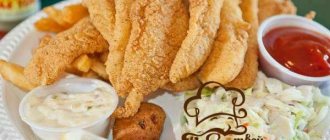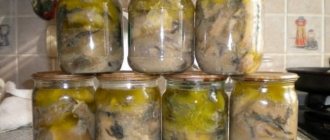Fried caviar
I can safely say that there are few people in our country who have never tried fried caviar in their lives. After all, the caviar of many fish can be fried; there are many dishes:
- Fried carp caviar;
- Fried pike caviar;
- Fried pike perch caviar;
- Fried crucian caviar.
Recently, crucian carp, we are talking about silver carp, are taking up more and more space on store shelves, and in the catches of professional fishermen. Another advantage of this fish is that it can be caught almost the entire season.
Despite all the pickiness of some fish lovers when it comes to silver crucian carp, one should pay tribute to the taste of its fried caviar. Moreover, silver crucian carp is a fish with a high content of caviar. Thus, fried crucian caviar can be a winning dish on your table.
Fried crucian caviar
The recipe for fried caviar is simple and universal - fried crucian carp caviar is prepared as simply as fried pike caviar. First, the caviar is carefully removed from the belly of the fish by hand. There is no need to rinse if you are not going to add it to your ear. Fried caviar is usually prepared from unwashed caviar.
Vegetable oil is poured into a flat frying pan and heated. Pieces of caviar are laid out in a frying pan and salted (only once). The frying pan is covered with a lid for three to four minutes (firstly, so that the caviar is slightly steamed; secondly, so as not to splash the stove with oil). When the bottom layer of caviar turns yellow and compacts, the caviar is carefully turned over with a wooden spatula or fork. The main thing is that the caviar is fried.
And now you have delicious fried caviar ready. It is best to place it in a shallow plate and let it cool. For fried caviar, you can serve boiled potatoes, fresh vegetable salad, or simply chopped vegetables with fresh dill, parsley, green onions and young garlic feathers.
The fish with a long, graceful body and white meat serves as the basis for preparing hundreds of delicious dishes. Its liver and caviar are prepared separately. Caviar is added to the fish soup, salted, fried in batter, baked, made into cutlets, meatballs, pancakes - caviar. Dishes made from grass carp caviar are no less tasty than those prepared from its meat.
Vitamin E, contained in fish and caviar, is important for the female body and contributes to a normal and painless pregnancy. For people who frequently experience cramps, eating caviar is a chance to reduce their occurrence. Caviar is useful for diabetics and hypertensive patients, suppresses the feeling of fatigue, and prevents excessive fatigue.
How to prepare grass carp caviar
Caviar, as a product of river fish, should be correctly removed from the abdomen, taking care not to damage the shells in which it is contained. After removal, the oysters with caviar are carefully and carefully wiped or washed in cold water. At the same time, blood, mucus, and remnants of entrails taken out along with the bags of caviar are removed.
The easiest option is to salt the caviar. They are salted like other caviar of fish from the carp family and other river species.
Quick salting - the washed and slightly dried caviar is peppered and salted, mixed, and allowed to stand for a few minutes.
Eat by spreading it on bread with butter. Or add chopped onions/green onions and vegetable oil.
Salting in brine - caviar is poured with a strong salt solution (100 g of salt per liter of water).
The brine, three times the volume of caviar, is brought to a boil and cooled to 60°. Pour in the caviar and mix. Keep in brine for 15–20 minutes. Then they hang it in a linen bag so that the remaining liquid drains and the caviar ripens. After a day, salted grass carp caviar is ready for consumption.
Quick or dry salting, according to gourmets, does not fully reveal the taste of caviar. Therefore, wet salting in brine is preferable. It takes longer and is safer if you remember that river fish and their eggs are often infected with parasites.

What can be prepared from grass carp caviar
Caviar is fried, baked, and made into caviar. Dishes made from grass carp caviar can be easily varied by adding different products.
First, 1-2 finely chopped onions are fried in vegetable oil until half cooked. Then add caviar to the onion and fry until all the caviar is the same color. Caviar is delicate and burns quickly, so it is often stirred and monitored for changes in shades. At the end of frying, you can add a little fish seasoning and dry herbs. The finished dish is sprinkled with chopped herbs and served with any side dish and sauce.
For 500 g of caviar you need:
- eggs - 2 pcs.
- onions - 2 heads
- flour - 4 tbsp. l.
Chopped onions and eggs are added to the caviar mass. Salt and pepper the mixture, slowly add flour and stir. Let the dough sit for half an hour. Then lightly beat the mixture to make the eggs more fluffy. Fry like regular pancakes, frying each side for 2-3 minutes over medium heat. Served with sour cream, mayonnaise, ketchup.
Fry fresh cabbage, add a little water and simmer until half cooked. At the end of stewing, add tomato sauce or paste, salt and pepper. Add a few grains of crushed coriander. (It can replace tomato; it is the best spice for cabbage). When the fried cabbage has cooled, mix it with caviar, beat in 1-2 eggs, mix thoroughly. Place on a sheet greased with vegetable oil and bake in the oven at 180° for 15 minutes. The proportions of caviar and cabbage are arbitrary.
You can use potatoes instead of cabbage. You will get potato caviar.
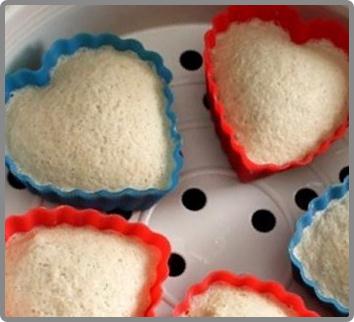
For 200 g of caviar you will need:
- Eggs - 2 pcs.
- Milk - 2 tbsp. l.
Eggs and milk are added to the caviar mass. Salt to taste. Beat well. Pour into molds, filling them to three-quarters of the height.
Happy cooking. May it be delicious for everyone!
Good fishing online stores will allow you to purchase any fishing goods at competitive prices!
Popular sections of the site:
The fisherman's calendar will allow you to understand how all the fish bite depending on the time of year and month.
The fishing gear page will tell you about many popular gear and devices for fishing.
Fishing baits - we describe in detail live, plant, artificial and unusual ones.
In the bait article you will get acquainted with the main types, as well as tactics for using them.
Learn all the fishing lures to become a real fisherman and learn how to choose the right one.
IT IS IMPORTANT TO KNOW! Fishermen caught 25 kg of fish using the Fish XXL bite activator! Read more.
Spicy rudd cutlets
To prepare this recipe for rudd cutlets you will need the bare minimum amount of ingredients. But you will have to stand at the stove a little longer - the fish broth, which also has to be cooked, gives these cutlets a special softness and flavor. We take:
- rudd - approximately 1 kg,
- onions - 2 pieces (1 for minced meat, 1 for broth),
- parsley root - 1 piece,
- parsley or dill - ½ bunch,
- lard - 100 grams,
- yesterday's white bread - 2 slices,
- milk - ½ cup,
- egg - 1 piece,
- salt, black pepper, spices - to taste,
- flour - 4 tablespoons,
- vegetable oil - 4 tablespoons.
First of all, we need to clean the fish: it is most convenient to skin the rudd, gut it, cut off the head and fins with the tail, and then make an incision along the back along the ridge and remove the fillet with skin from the bones. Place the heads, fins and tails with ridges in a separate pan and fill with water (you only need a little, ½ liter is enough).
We put the pan on the fire, add one peeled onion and parsley root, which should also be peeled first. Salt, you can add pepper in a pot. Maintain medium heat and cook until foam forms, remove it and let it simmer a little more until we start frying our rudd cutlets.
Let's return to the fish fillet. You need to make minced meat from it, which means we pass it through a meat grinder and set it aside. Pour milk over the bread slices and let stand for 10 minutes, while at this time we peel and cut the onion into cubes. Cut the lard into pieces. After this, we put the minced meat into the meat grinder again, but with onions, lard, soaked bread and twist it again - this way the bones will become softer and will not be felt.
Add the egg, chopped herbs, spices and salt to the minced meat, mix and scoop it with wet hands to form cutlets. They will need to be rolled in flour. When the cutlet preparations are made, the broth is boiling on the stove, take a time out for 5 minutes and look at the “Fishing Everyone!” website, and then, with fresh energy, start frying the cutlets.
We suggest you read: Catching grass carp with a cucumber
Heat the oil in a frying pan, set the heat not too high - the cutlets should form a crust, but not burn in a matter of minutes. When the oil is hot, place the cutlets in the frying pan and fry until golden brown. Then we turn it over. At this point, the fire under the fish broth must be turned off, and the broth itself must be passed through a sieve, cheesecloth or colander to filter out the bones and heads.
Carefully, so as not to burn yourself, pour the hot broth into the frying pan. It should cover the cutlets by about two-thirds. Now cover the pan with a lid, reduce the heat to low and simmer for about 10 minutes. Then the finished rudd cutlets can be safely served, and if you thicken the remaining broth in the pan with a couple of tablespoons of flour and sour cream, you will get an excellent sauce.
If your rudd catch turned out to be rich, but you are already tired of ordinary fish cutlets, diversify them with non-standard ingredients. And for a hint, use our recipe for spicy rudd cutlets!
Let's take ingredients that are quite standard for cutlets: fish - about 1-1.5 kilograms, salt, egg, onion - 1 piece, a piece of lard 50 grams or the same amount of butter, 2 tablespoons of semolina. And the following products will complement our recipe:
- fresh ginger - a 2-centimeter piece or 1 tablespoon dried,
- garlic - 3 cloves,
- ground black pepper - ½ teaspoon,
- red pepper flakes - ½ teaspoon,
- zest of 1 lemon,
- cilantro - ½ bunch.
Let's start preparing the rudd - you need to clean it, remove the head, fins, and giblets. Now we wash all the fish well and send it to a mechanical meat grinder, from which we first remove the knife. This way the fillet will be removed from the bones, and they will gradually be wound onto the shaft of the meat grinder, and the finished minced meat will remain in the bowl.
Then we clean the meat grinder and assemble it correctly. Again we send minced fish with lard there, scroll through. If you use butter instead of lard, simply add it to the minced meat. Peel the onion and chop finely. Fry it a little in vegetable oil. There, in the boiling oil, when the onion becomes transparent, add spices - peppers, salt, squeeze the garlic through a press.
Immediately turn off the heat and let it simmer a little, then add it to the fish. Beat the egg into the minced meat, peel the ginger and grate it. Mix the minced meat with ginger and grated zest, add chopped cilantro. Stir, adding semolina, until the minced meat becomes medium thick. Then let it sit for 5 minutes so that the semolina swells, form cutlets and fry in oil.
We invite you to familiarize yourself with: Working gear for catching crucian carp and making it yourself
White amur
Grass carp is one of the most striking representatives of the carp family. The homeland of this fish is considered to be East Asia, where it inhabits water bodies from the Amur River to Southern China. Alas, at present the natural population of fish has sharply decreased, so carp is the main object of artificial breeding.
A group of fishermen revealed the name of the secret bait during interrogation.
Category: regional news.
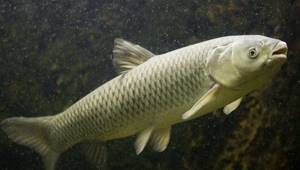
Cupid is bred not only because of its low population, but also because of its excellent taste, rapid weight gain and ability to reach record sizes. Malek gains 300-800 grams in 2-3 years, which is several times faster than its relatives.
Beneficial features
Grass carp is a fish of high nutritional value. The meat of this fish is dense and fatty, contains vitamins A, B, C, E, and can be subjected to any type of heat treatment. It can be fried, smoked, stewed, stuffed. The ear deserves special praise. The meat of this fish, being a natural antioxidant, has a beneficial effect on regulating the functioning of the human heart, blood vessels and brain.
However, due to its high fat and calorie content, fish is not suitable for consumption on a low-calorie diet.
How to increase your fish catch?
Over 7 years of active fishing, I have found dozens of ways to improve the bite. Here are the most effective ones:
Fish live in schools. Cupid is characterized by great endurance; it easily survives in conditions unsuitable for life for other species of the carp family. It can live in salt water (up to 10 grams/liter) and tolerates frosty winters quite well.
Grass carp prefers to live in places with an abundance of aquatic vegetation. Therefore, most often it can be found on water utilities, small rivers and reservoirs. Again, when you are looking for fish, you should pay attention to places where there is a lot of algae.
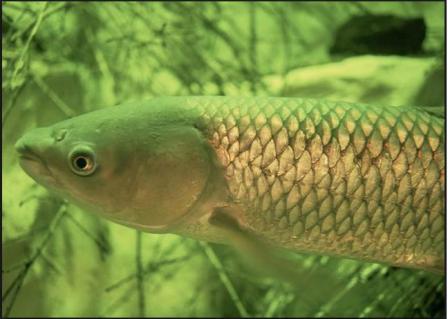
It prefers to live in reservoirs with a large food supply, but spawns only in the current. In most rivers of central Russia, grass carp has completely acclimatized and its population is increasing. So this fish is not in danger of extinction.
Grass carp is a very large, peaceful fish, with a maximum length of 120 cm and a weight of 30 kg. The body is slightly oblong, covered with dense scales and practically not flattened on the sides. The fish's forehead is very wide.
White carp is a fish of amazing beauty. Its greenish-gray back, dark golden sides and dark rim separating the edges of its scales simply fascinate the eyes of fishermen. The fish has a very beautiful light golden belly. The fins are light, with the exception of the dorsal and ventral, they are darker. There is a golden iris in the eyes.
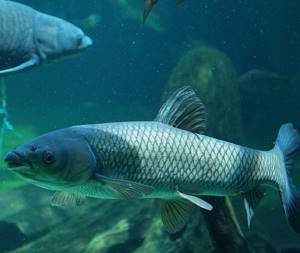
Grass carp very often becomes an object of pond fishing. Very often, carp can be caught in reservoirs used to cool power plants. Unfortunately, in such conditions, carp cannot spawn on its own, but its larvae are imported from fisheries.
The spawning time of grass carp, unlike its relatives, is determined not only by weather conditions and water temperature, but also by the availability of food supply. Yes, that’s how it turns out, cupid is also thinking about what his fry will eat.
Typically, spawning occurs in May, less often in June, depending on the region and weather conditions, the main signal for spawning for grass carp is the achievement of a water temperature of 26-29 ° C. In winter, carp descends into hibernation pits, and the development of embryos occurs like silver carp.
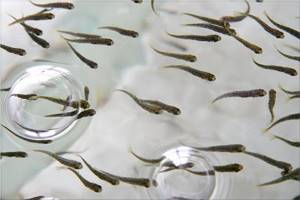
If there is not enough food in the reservoir, the development of eggs is significantly delayed, and the fertility of the fish decreases. Under normal conditions, an individual weighing 6 kilograms produces up to 1 million eggs, which are deposited into the water column.
Natural conditions for spawning are preferably the beds of large rivers with very strong currents. Mass spawning of carp occurs when the water temperature reaches 23-28 °C. This gives benefits during artificial reproduction by controlling the timing of spawning by regulating the water temperature.
A significant disadvantage of grass carp is that it refuses to spawn at temperatures below 26 ° C and spawns only in running water. For this reason, carp do not spawn in most natural bodies of water.
Cupid is especially active in April and May. It will not be possible to clearly say where exactly to look for carp, but it can be argued that the reservoir must be populated artificially and there must be a lot of aquatic vegetation at the fishing site.
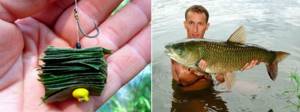
IT IS IMPORTANT TO KNOW! Fishermen caught 25 kg of fish using the Fish XXL bite activator! Read more.
Basically, fishermen prefer to catch grass carp using a float rod; by the way, the fish are quite strong, so equip everything very carefully. Bait for grass carp is a must, and canned corn is the best bait. Fish does not react well to flavorings, so their use is highly undesirable.
You can also use tender, young vegetation as bait; this can be the ovary of cucumbers, young stalks of corn, several young pea leaves, you can clear the thorns from aloe leaves. The bait is tied to a hook using floss threads, the color of which matches it.
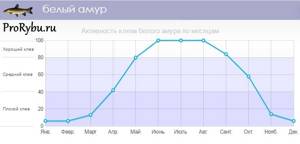
The biting activity of grass carp is quite predictable, so experienced fishermen have long been able to make a bite forecast. Well, for those who have less experience behind them, we suggest looking at the grass carp biting calendar and using it to choose days for fishing. Click image for a larger view.
January is a slow month for catching grass carp. The likelihood of a fish biting is reduced to zero. We can safely say that he does not bite.
A group of fishermen revealed the name of the secret bait during interrogation.
Category: regional news.
In February, carp activity is not observed. The fish don't bite at all.
With the onset of spring warmth, the fish begin to wake up, but in March, carp bite very rarely. His capture can be considered a great success
The warmth of April awakens the carp after hibernation, but the fish still remains passive and reluctantly takes the offered bait.
If in your region in May the water temperature reaches 12-16 degrees, then carp begins to be caught very well.
In June, fishing for grass carp begins to bring the desired results. It is in this month that the fish bite best.
White carp fish silver carp photo squad carp river cow
White carp, or belamur (lat. Ctenopharyngodon idella), belongs to the carp fish and forms the monotypic genus of the same name.
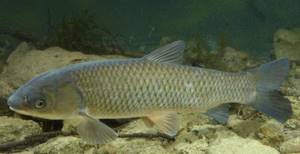
The species is characterized by several everyday humorous names (water cow, grass carp, underwater mower), which clearly indicate lifestyle and gastronomic preferences.
Thanks to a diet of algae and plants, the fish has tasty and healthy meat and is massively bred in lake and pond ecosystems both for the purpose of commercial fishing and to rid water bodies of excess flora of all types.
The homeland of grass carp is the Far East with its main habitat in the middle and lower reaches of the Amur, including the desalinated shelf of the Sea of Okhotsk.
Fierce food competition with numerous representatives of char, salmon, sturgeon, and mullet forced the fish to completely switch to phytofeed, where there were fewer potential competitors: bighead carp (bighead), local forms of bream and chebak, black carp (Chinese roach).
The latter is not a species relative of the belamur and forms its own genus (lat. Mylopharyngodon), which is on the verge of extinction in Russia, and in China is intensively bred in artificial fresh water bodies.
This species is quite easily identified by its non-standard appearance for representatives of the carp family:
- an elongated body of round cross-section (cylinder) with minimally pressed sides;
- small head with a strongly flattened forehead;
- the mouth with fleshy lips is directed downward;
- pectoral fins are placed close to the rear edge of the gill covers, decorated with radial stripes;
- rounded back dark olive or ash gray;
- eyes with golden irises;
- light belly;
- silvery or yellowish sides with large and tightly attached cycloid scales, which are characterized by smoothed edges (40-47 in a row).
In addition, the fish has a very short dorsal fin with 8-10 rays, inferior in size to the anal fin (11). The largest grass carp grows up to 120 cm and weighs 40 kg, but standard catches are dominated by young individuals (3-5 years old) weighing 2-6 kg.
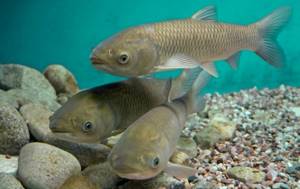
Description of bluefish fish: habitats and fishing methods
The indigenous Amur resident has been successfully introduced into the water bodies of the European part of Russia. It is especially numerous in the river systems of the Don, Ural, Kuban, and Volga. The species has a wide range of temperature tolerance and unpretentiousness regarding the oxygen regime.
Thanks to historical memory, it thrives in cold water from 0 to 5C, but prefers warm bodies of water (ponds, reservoirs, lakes, irrigation canals) with summer temperatures of 25-30C and above, since such conditions are most favorable for the active development of aquatic vegetation.
Grass carp is a large herbivorous fish that is capable of eating food at the level of 110-130% of its current weight per day.
The constant need for food is explained by the short intestines (no more than half the length of the body), which processes the food eaten too quickly, leaving a constant feeling of hunger.
On the other hand, the accelerated functioning of the digestive tract allows for rapid weight gain (1-3 kg per year), which explains its mass commercial introduction into the pond and river culture of Russia.
The basis of the diet of grass carp is plant food, but, like all cyprinids, it can be omnivorous if there is a deficiency of the phyto-feed base. Fish eats:
- Characeae and duckweed;
- filamentous and soft grass;
- reed and hornwort;
- cereals and waste from their processing;
- small crustaceans and worms;
- bloodworms, leeches, insects, mollusks;
- emergent plants and zooplankton.
During the hungry season, it often eats the eggs and larvae of other fish and even begins to chase the fry, so when breeding grass carp, farms practice artificial feeding of the species by regularly throwing mowed soft grass, reed leaves or standard carp feed mixtures into the reservoir.
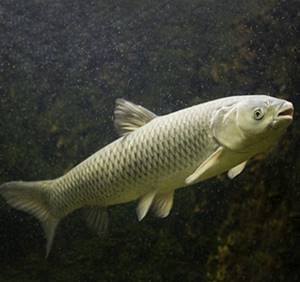
Food activity persists from April to mid-October. When the water temperature drops to 8-9C in autumn, the fish stops feeding and prepares for the winter, choosing the deepest holes at the bottom of the reservoir.
We invite you to familiarize yourself with Pomegranate planting and care - AgroXXI
In the warm season, it gathers in large flocks and spends almost all its time among thickets and on plantations with bottom vegetation, filamentous algae, and duckweed.
Grass carp can feed in any layer of the reservoir if there is suitable food there.
The fish is not shy, but is quite careful. If there is a suspicious noise, it immediately moves to another section of the reservoir and for a long time ignores the place it does not like.
Spawning
Sexual maturity occurs at 7-9 years with a body length of 60-75 cm, but can naturally accelerate under conditions of abundant nutrition and forced growth.
For grass carp to spawn, clean shallow water with a fairly strong current and a hard bottom (stone, pebbles, clay) is necessary. The water temperature should be at least 25-26 C.
That is why grass carp spawns later than other species - in June-July.
Description and characteristics of Baikal grayling
An adult female is capable of laying up to 1.5 million pelagic eggs, which rise to the upper layers of water and are carried over long distances by the current. The incubation period of grass carp eggs takes minimal time.
Having reached a height of 3-4 cm, the white carp fry gradually switches to plant food.
If there are no conditions for a normal spawning process in a reservoir, the fish completely stops reproducing. The resorption mechanism (Latin resorbeo - absorb) is activated in the body of females, and the eggs self-destruct.
Fishing for grass carp
Fishing for grass carp is only possible in the warm season, since it stops feeding when the water temperature is below 9-10 C. When choosing a fishing spot, you need to focus on areas with an abundance of vegetation.
If you have the opportunity to first observe the reservoir from a small hill, you should definitely take advantage of it.
In search of food, fish regularly make vertical migrations to the upper layers, revealing their presence with splashes, breakers, and tail swings above the water.
Grass carp has an excellent sense of smell and responds well to crumbly and granular baits, quickly swooping onto the bait spot.
You can use both purchased and homemade mixtures that form large nutritious flakes or a stable cloud of turbidity.
The excellent appetite and omnivorous nature of grass carp significantly expand the choice of baits not only of plant, but also of animal origin:
- young leaves of cabbage, beets, lettuce, dandelion, mint;
- a sprig of parsley, dill, spinach;
- a piece of green cucumber;
- boiled peas, corn, pearl barley, potatoes, wheat;
- algae, reed stems, cucumber ovary;
- leaves of alder, willow, young peas or beans;
- bread crumb, dough, mastyrka;
- locust, grasshopper, crawling;
- dung and earthworm;
- bloodworms, maggots, chicken liver.
Silver carp: description, habits, fishing and benefits of fish
Catching beloamur with boilies made from soybean, corn or semolina with the addition of chopped mint, dill, basil and sunflower seeds is highly effective. Food coloring is used to give the treat the desired shade (green, pink, orange).
We suggest you familiarize yourself with What is mistletoe
Tackle
Grass carp combines great mass and strength, and therefore requires the use of durable equipment, especially in areas with abundant aquatic vegetation.
Usually they use a rigid rod about 3.5 meters long, a spinning reel with a frictional and large spool diameter (4000), reinforced monofilament with a thickness of 0.35-0.55 mm, large hooks with a short shank No. 8-10 according to international numbering (No. 5 -6 according to the Russian standard).
For fishing, both classic donka and feeder equipment are used. The latter is more effective due to the possibility of precise feeding and high casting range.
The cautious grass carp behaves carelessly far from the shore and takes the bait much more readily. To further increase the chance of a successful bite, you need to install a long leash (50-60 cm).
An attempt to install an additional hook is the main reason for the landing of fish due to snags on hard aquatic vegetation.
Zig-rig equipment
The Zig-rig tackle allows you to hold the bait at the desired depth without much effort. This is all the more important because you can successfully catch grass carp not only at the bottom, but also in mid-water.
In spring and summer, fish spend a lot of time close to the surface, actively eating algae and plant stems. The buoyancy of the Zig-rig is provided by a teardrop-shaped underwater float, which works in tandem with a sliding sinker.
A piece of foam plastic is additionally attached to the hook to hold light baits in the water column or a floating boilie.
Belamur feeds non-stop from early morning until late evening. But it’s better to catch it in the first half of the day, when the fish are as hungry as possible.
To avoid spooking the prey with unnecessary noise and movements, a long cast is required. If the school is close to the shore, the angler takes a position to the side and casts the bait diagonally.
But fishing from the opposite shore is especially popular.
Vobla - what kind of fish, description and way of life
You should not throw in bait at the very beginning of fishing, which, falling into the water, can scare away the peacefully feeding fish. You should create a bait cloud of turbidity only when there has not been a single bite for an hour or an hour and a half. Sometimes it is advisable to attach several promising places at once, and start fishing in a calmly unfed area.
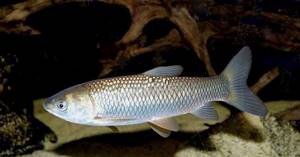
The hooking time depends on the type of nozzle. If there is a bunch of greenery or a piece of cabbage leaf on the hook, you need to wait for the tip of the feeder or float to constantly tremble and make a sharp and strong swing of the rod.
With compact baits (boilie, crawler, corn), grass carp does not stand on ceremony, immediately grabs it and tries to stroke it. In such a situation, an immediate hook is required as soon as the bite alarm goes off.
